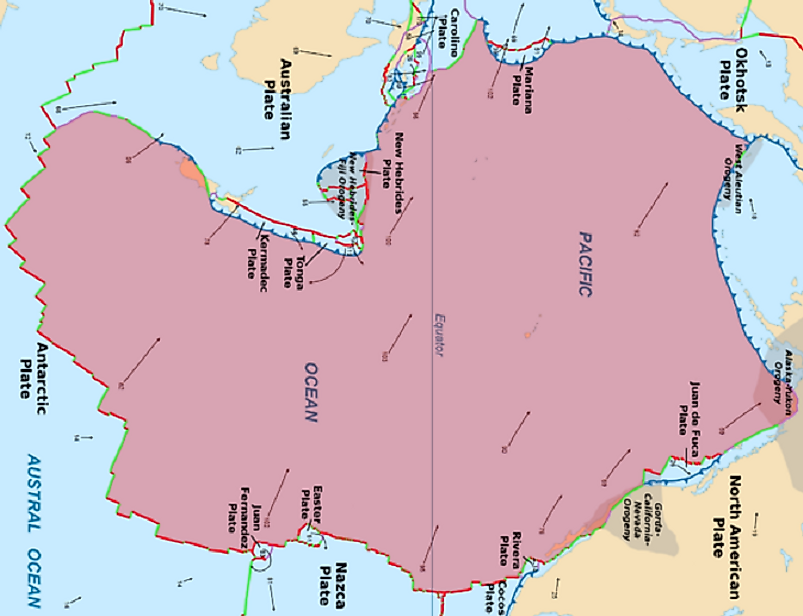What Is The Pacific Plate?

The Saga of Continental Drift
According to the study of plate tectonics, the earth’s outermost layer, the lithosphere, is divided into huge tectonic plates that glide over the mantle that sits above the fluid lava core. The plates perform as hard and rigid shells which constitute the foundations of our terrestrial geography. However, the lithosphere is not as rigid as we would like to think. The tectonic plates keep moving at the speed at which our fingernails grow. Throughout earth’s history, these plates have cyclically crashed against each other, died out, and been recreated. 200 million years ago, most of these plates joined the surface landmasses into a super-continent called Pangaea, which surrounded a mega-ocean called Panthalassa. Between 190 and 180 million years ago, this humongous landmass began to break up along what is now Africa. As Pangaea continued to drift apart, it created most of the tectonic plates which constitute the present lithosphere. One of them was the Pacific Plate, the largest of all modern plates at 103 million square kilometers.
Northern and Eastern Neighbors
The Pacific Plate constitutes most of the seafloor of the Pacific Ocean. On its northern side, the Plate subducts under the North-American Plate, forming a convergent boundary and the Aleutian Trench along the islands of the same name. It has a divergent boundary with the Explorer Plate off the west coast of Vancouver Island, Canada. The eastern and southeastern parts of the Pacific Plate jostles against the Juan de Fuca, Cocos, and Nazca Plates, which are subducting under the North American Plate. In the middle of its eastern side, the San Andreas Fault forms a boundary with the North American Plate.
Southern and Western Dynamics
The southern side of the Pacific Plate forms a divergent boundary with the Antarctic Plate, and gives rise to the Pacific-Antarctic underwater ridge. The western edges of the Pacific Plate meet the Okhotsk Plate, which forms two underwater trenches off of the coast of Japan. The Western part of the Pacific Plate is subducting under the Philippine Sea Plate, forming a convergent boundary. It has created the Mariana Trench, which is the deepest part of the Pacific Ocean, or any other ocean of the world for that matter. The Pacific Plate forms a relatively harmless transform boundary with the Caroline Plate near the equator to the north of New Guinea. Nearby, in the Bismarck Sea, the Pacific Plate collides against the North Bismarck Plate. In the southwest, the Pacific Plate has a mutually subducting relationship with the Indo-Australian Plate. Forming a mostly convergent boundary, it subducts under the other, just north of New Zealand, forming underwater trenches. Then, near the Alpine Fault at New Zealand’s South Sea Island, the Pacific Plate forms a transform boundary where the Indo-Australian Plate subducts under it, creating the Puysegur Trench. The largest block of Pacific Plate’s continental crust is located near Zealandia, east of the Puysegur.
A Museum of Plate Tectonics
The subductions along the outer limits of the Pacific Ocean produce a great arc of earthquakes and volcanic activity, famously known as the "Ring of Fire". The hot spot under the Pacific Plate near the far southwestern Pacific reaches of the USA gave rise to the Hawaiian Islands. The Pacific Plate acts a sort of "museum" of underwater paleo-geology. As such, it contains the largest area with remnants of the oldest geological players under the seabed inside the Asian oceanic trenches. There are evidences that the minor plates of Juan de Fuca, Nazca, and Cocos are what remain of an earlier plate called the Farallon. A geological map of the seabed of the Pacific Ocean uncovers geologic sequences over millions of years, and house information that they formed the Ring of Fire on the perimeters of the largest ocean. The Pacific Plate can show the chronology of the Pacific seafloor in a stair-step way, with the oldest being subducted into Asian Pacific trenches as early as 145 million years ago. Today, the Pacific Plate, along with the Pacific Ocean Basin, is shrinking. This is occurring as North and South America are moving westwards, widening the Atlantic Ocean at the cost of the Pacific's own breadth.











